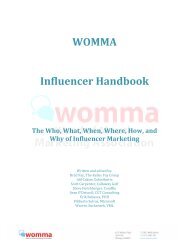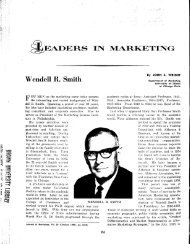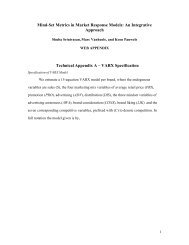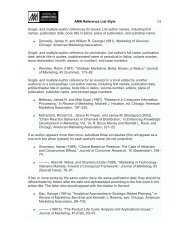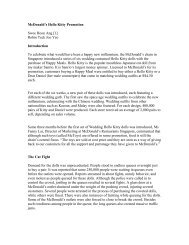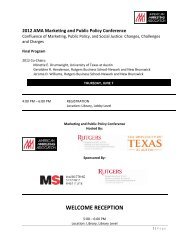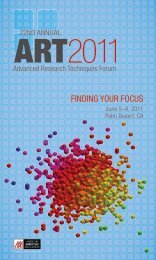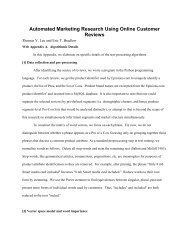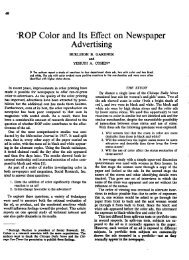Collectible Toys 1 Collectible Toys as Marketing Tools - American ...
Collectible Toys 1 Collectible Toys as Marketing Tools - American ...
Collectible Toys 1 Collectible Toys as Marketing Tools - American ...
You also want an ePaper? Increase the reach of your titles
YUMPU automatically turns print PDFs into web optimized ePapers that Google loves.
© 2011, <strong>American</strong> <strong>Marketing</strong> Association<br />
Journal of Public Policy & <strong>Marketing</strong><br />
PrePrint, Unedited<br />
All rights reserved. Cannot be reprinted without the express<br />
permission of the <strong>American</strong> <strong>Marketing</strong> Association.<br />
<strong>Collectible</strong> <strong>Toys</strong> 1<br />
<strong>Collectible</strong> <strong>Toys</strong> <strong>as</strong> <strong>Marketing</strong> <strong>Tools</strong>: Understanding Preschool Children’s Responses to Foods<br />
Paired with Premiums<br />
Anna R. McAlister<br />
Lecturer<br />
Department of Consumer Science<br />
University of Wisconsin - Madison<br />
1305 Linden Drive<br />
Madison WI 53706<br />
Phone: 734 355 3758<br />
Email: armcalister@wisc.edu<br />
T. Bettina Cornwell<br />
Edwin E. and June Woldt Cone Professor of <strong>Marketing</strong><br />
Research Director, Warsaw Sports <strong>Marketing</strong> Center<br />
Lundquist College of Business<br />
University of Oregon<br />
Eugene OR 97403<br />
Email: tbc@uoregon.edu<br />
The authors acknowledge the parents and preschool teachers whose consent to the research<br />
project w<strong>as</strong> fundamental to its success. The authors also thank Sean B. C<strong>as</strong>h (School of Nutrition<br />
Science and Policy, Tufts University) for his expertise and advice in preparing the final version<br />
of this paper.
<strong>Collectible</strong> <strong>Toys</strong> 2<br />
<strong>Collectible</strong> <strong>Toys</strong> <strong>as</strong> <strong>Marketing</strong> <strong>Tools</strong>: Understanding Preschool Children’s Responses to<br />
Foods Paired with Premiums<br />
Concern over obesity finds policy makers struggling to understand marketing’s role in food<br />
choice but with a limited empirical b<strong>as</strong>e to inform them. Because food patterns established in<br />
childhood influence life-long patterns, toy premiums that may sway food preference are being<br />
questioned. The motivational pull of collectible toys is of particular interest in this discussion<br />
since repeated exposure to foods engendered by frequent purch<strong>as</strong>es to obtain collectibles may<br />
establish food preference. Thus, Study 1 addresses the role of collectible toys <strong>as</strong> premiums<br />
accompanying food offerings. These premiums are shown to influence children’s attitudes<br />
toward both “unhealthy” and “healthy” meal offerings. In Study 2, a choice t<strong>as</strong>k finds that a<br />
healthy meal is favored when it is paired with a collectible toy premium and the unhealthy meal<br />
is presented with no premium. Findings are discussed in terms of providing an evidence b<strong>as</strong>e for<br />
policy decisions.<br />
Keywords: child health, obesity, meals, t<strong>as</strong>te perceptions, f<strong>as</strong>t food
<strong>Collectible</strong> <strong>Toys</strong> 3<br />
A strong argument can be made for change in children’s food consumption behaviors. A<br />
review of the literature on food preferences finds that “the ready availability of energy-dense<br />
foods, high in sugar, fat and salt, provides an eating environment that fosters food preferences<br />
inconsistent with dietary guidelines” (Birch 1999, p. 41). Moreover, children like foods high in<br />
sugar, salt, and fat (Cooke 2007). Policy makers are under pressure to do something about the<br />
obesogenic environment that fosters overweight and obesity in children, and marketing practices<br />
that target children are center stage in many debates.<br />
In response to mounting public pressure for change, Santa Clara County in California<br />
voted to ban the practice of pairing toys with high calorie meals targeted to children, while<br />
allowing toys to be paired with meals that meet certain nutritional guidelines (Bernstein 2010).<br />
San Francisco County h<strong>as</strong> since adopted the same policy (Frumkin 2011). In a policy volley,<br />
restaurant lobbyists have supported state lawmakers in Florida and Arizona to prevent toy bans<br />
from reaching their states. These lobbyists explained that they felt the need to be proactive in<br />
helping to prepare legislation that would make it illegal “…to try to regulate any incentives that<br />
restaurants provide to entice customers” (Bernstein 2011).<br />
At issue in the current policy debate is the appropriateness of government intervention.<br />
While restaurant owners <strong>as</strong>sert that parents should decide what food their children will consume<br />
and whether or not they may have a toy (Bernstein 2011), parents are divided on the issue. Some<br />
parents argue that the proposed bans interfere with a consumer’s right to choose, while others in<br />
2010 chose to join the Center for Science in the Public Interest in filing a lawsuit against<br />
McDonald’s (de Nies and Behrendt 2010). The lawsuit claimed that inclusion of toys in<br />
McDonald’s Happy Meals is deceptive, predatory, and “downright illegal” (Parsons 2010).<br />
Expenditure figures speak to the use of toys to promote foods. In 2006, for example, the
<strong>Collectible</strong> <strong>Toys</strong> 4<br />
f<strong>as</strong>t food industry spent approximately $350 million on advertising toy promotions (Bernstein<br />
2011; Parsons 2010). The most recent F<strong>as</strong>t Food FACTS (Food Advertising to Children and<br />
Teens Score) Brief from the Rudd Center for Food Policy and Obesity concludes that youth<br />
oriented marketing is highly effective (Rudd Center 2010). The brief finds that 15% of parents of<br />
preschool children reported that their child <strong>as</strong>ks them to visit McDonald’s every day. Moreover,<br />
15-19% of parents who went to McDonald’s and Burger King reported that their child wanted<br />
the restaurant’s toy.<br />
History h<strong>as</strong> shown that toys offered with kids’ meals in quick service restaurants are<br />
highly sought after and occ<strong>as</strong>ionally the source of controversy. In 1997, for example, a Teenie<br />
Beanie Babies promotion at McDonald’s became a “cult phenomenon” when 100 million stuffed<br />
toys proved insufficient to satisfy the number of people eager to take one home. Adults<br />
purch<strong>as</strong>ed the kids’ meals, and in many c<strong>as</strong>es the food w<strong>as</strong> left to w<strong>as</strong>te in overflowing tr<strong>as</strong>hcans<br />
(Altaner 1998). Balancing the popularity of kids’ meal toys against concerns that the toys may<br />
encourage obesity through poor food choice, a compromise would be to allow toys, but only<br />
when they are used to promote meals meeting strict nutritional guidelines. This is the type of<br />
proposal discussed previously and currently being considered in New York (Daily Mail 2011).<br />
Importantly in this policy battle, there is very little in the way of directly relevant<br />
research to inform the debate. One must question whether intervention is needed and, if so, what<br />
form it might take. Thus, this research examines children’s responses to foods coupled with toys.<br />
We aim to determine whether nutritious meals could be effectively promoted through the<br />
inclusion of toys (collectible or non-collectible). Further, the current research explores the role<br />
toys may play in promoting exposure to foods by motivating preference. The current research<br />
seeks to advance understanding of how very young children choose more or less healthy foods
<strong>Collectible</strong> <strong>Toys</strong> 5<br />
when these foods are offered with toys. This population, context, and choice behavior have not<br />
previously been investigated.<br />
<strong>Marketing</strong> to Children and the Use of Premiums<br />
Premiums are goods that are offered <strong>as</strong> a bonus to incentivize the purch<strong>as</strong>e of a product<br />
(Kotler, Brown, Adam, Burton and Armstrong 2007). Examples that are popular with children<br />
include cereal box toys, trading cards, and toys paired with kids’ meals at restaurants. The<br />
present research focuses particularly on collectible toys <strong>as</strong> premiums. We define “collectible toy<br />
premiums” <strong>as</strong> toys known to belong to part of a larger, pre-defined set, and that are offered <strong>as</strong> a<br />
bonus to promote the purch<strong>as</strong>e of another product. Why are collectible toy premiums of<br />
particular interest? When paired with meals, collectible toy premiums may lead to repeat<br />
exposure to certain foods. Repeat exposure may, in turn, lead to incre<strong>as</strong>ed preference for those<br />
foods (Birch and Marlin 1982; Harris 2008; Skinner et al. 2002). Further, many preferences<br />
developed in childhood persist, and preferences for unhealthy foods could result in both short-<br />
term and long-term negative health consequences (Kemm 1987).<br />
Importantly, from the child’s perspective, a toy premium paired with food facilitates an<br />
<strong>as</strong>sociative learning experience that may sway food preference. Parents complain that their in-<br />
home attempts to promote healthy eating cannot compare to the ways in which children’s food<br />
preferences are shaped by marketing efforts (Health News 2011). Regarding f<strong>as</strong>t food (much of<br />
which is considered unhealthy), toy premiums have been cited <strong>as</strong> the primary incentive used to<br />
attract children and McDonald’s h<strong>as</strong> been named <strong>as</strong> one of America’s largest distributors of toys<br />
(Schlosser 2001). In one Australian survey, many of the 800 adult respondents regarded the<br />
pairing of collectible toy premiums with kids’ meal deals <strong>as</strong> “pester power” used by restaurants<br />
(Obesity Policy Coalition 2009).
<strong>Collectible</strong> <strong>Toys</strong> 6<br />
Premiums have been investigated for their potential to shape child preference for an<br />
advertised food, but findings are mixed. In the mid 1970s to early 1980s, studies emerged in<br />
response to the Federal Trade Commission’s (FTC) proposed ban on child-directed television<br />
commercials using premiums (note that the discussion w<strong>as</strong> not focused on collectible toy<br />
premiums per se). On the b<strong>as</strong>is of findings reported by Shimp, Dyer, and Divita (1976), the FTC<br />
ban w<strong>as</strong> rejected. These researchers tested first through sixth grade children’s responses to<br />
advertisements in an experiment <strong>as</strong>sessing the effectiveness of advertisement length and<br />
presence or absence of a NFL team patch offered with the cereal. They reported that greater<br />
liking of the premium did not necessarily translate to greater liking of the cereal. The researchers<br />
did, however, acknowledge that the non-significant result might have been affected by the lack<br />
of variance in children’s liking of the premium (that w<strong>as</strong> near ceiling).<br />
Miller and Busch (1979) reported that inclusion of a premium in an advertisement for<br />
breakf<strong>as</strong>t cereal did impact children’s likelihood of selecting the cereal in a choice t<strong>as</strong>k. Similar<br />
to Shimp and colleagues (1976), Miller and Busch (1979) used a well-controlled experimental<br />
design to test first through fifth grade children. The premium used w<strong>as</strong> a cartoon book and their<br />
findings were that “premium commercials showed a clear superiority over host-selling and<br />
announcer commercials <strong>as</strong> me<strong>as</strong>ured by the percentage of children who selected the advertised<br />
product” (Miller and Busch 1979, p. 330). While the mixed results across these studies are<br />
difficult to interpret, it can at the le<strong>as</strong>t be concluded that Miller and Busch’s (1979) use of a<br />
gender neutral Tweety and Sylvester cartoon premium, with no known ceiling or floor effects in<br />
likeability, may have produced more meaningful results.<br />
Observational research in the supermarket cereal aisle suggests children’s purch<strong>as</strong>e<br />
requests are frequently grounded in information about premiums learned from advertisements
<strong>Collectible</strong> <strong>Toys</strong> 7<br />
(Atkin 1978). Moreover, premiums are prevalent in child-directed advertising. In a content<br />
analysis of child-directed food advertising, close to one third of all ads sampled included a<br />
premium offering (Roberts and Pettigrew 2007). Although some of the early data suggest that<br />
premiums were not effective in terms of encouraging food preference, the fact that premium<br />
advertising (which commonly includes collectible toy premiums) is still prevalent suggests that<br />
marketers believe otherwise.<br />
<strong>Collectible</strong> Toy Premiums<br />
Interestingly, studies examining the use of premiums <strong>as</strong> incentives for children’s food<br />
purch<strong>as</strong>e decisions have not examined collectible toy premiums. One point of importance<br />
regarding the use of collectible toy premiums to promote kids’ meals is that once a child obtains<br />
the first toy from a collectible set, the desire to complete the set is so strong that children nag to<br />
obtain the remaining items (Roberts and Pettigrew 2007). In other words, what might have been<br />
a one-meal-purch<strong>as</strong>e inspired by a young child’s interest in a toy translates into four, five, or<br />
more purch<strong>as</strong>es depending on the number of toys needed to complete the collectible set.<br />
Recent research in developmental psychology h<strong>as</strong> shown that the “motivational pull of<br />
collectible toys is very strong” (McAlister, Cornwell and Cornain 2011, p. 15). In two<br />
experiments, the researchers showed that the majority of preschool aged children have the<br />
requisite skills for collecting. For example, they are able to employ decision rules to categorize<br />
items <strong>as</strong> belonging (or not belonging) to a set and they are able to resist distracting options when<br />
building a set. Moreover, these researchers demonstrated that the desire to collect can be strong<br />
enough for a young child to be willing to “pay a cost” of sharing with a confederate child in an<br />
experiment in order to obtain a collectible toy. The researchers offered children either a packet<br />
containing two toys (one collectible and one distracter) with the condition that one must be
<strong>Collectible</strong> <strong>Toys</strong> 8<br />
surrendered to another child, or a packet with two toys to keep (both non-collectible distracters).<br />
The majority of preschoolers in the sample chose the former option, surrendered the distracter<br />
toy to the confederate child, and kept the one collectible toy.<br />
Due to the concern that collectible toy premiums exert a particularly powerful influence<br />
when paired with a meal option, the present research is designed to look at collectible toy<br />
premiums and to compare the allure of collectible toy premiums to that of non-collectibles.<br />
Hence, one of the contributions of the present research will be to provide an <strong>as</strong>sessment of the<br />
“pull” of each type of premium using a repeated me<strong>as</strong>ures design. While current policy debates<br />
focus on the pairing of toys with food, we argue that this discussion should be enlarged to<br />
consider the motivational pull of a collectible <strong>as</strong> unique and different to non-collectible toy<br />
premiums. As a general contribution of the research, it is important to understand the potential of<br />
a collectible toy premium to motivate behavior differently than a single, non-collectible<br />
premium.<br />
Given that the current policy debate allows the use of toy premiums with meals following<br />
health guidelines, we consider meals that match suggested guidelines, while also examining<br />
energy dense, high calorie meals. In the following two studies, we have chosen to compare a<br />
calorie dense meal (pizza, fries, soda) with a healthier alternative (vegetables, soup, low fat<br />
milk). For e<strong>as</strong>e of reference, we label the calorie dense meal “f<strong>as</strong>t food,” though we acknowledge<br />
that either meal is potentially a quick service restaurant option. Study 1 employs a 2 (meal type:<br />
f<strong>as</strong>t food, healthy meal) x 3 (premium: collectible toy premium, non-collectible toy premium, no<br />
premium) within-subjects design to <strong>as</strong>sess children’s attitudes toward different offerings. Each<br />
child rates the six meals arising from the 2 x 3 design. Study 2 h<strong>as</strong> two <strong>as</strong>pects; one is a<br />
replication and extension of the within-subjects rating t<strong>as</strong>k from Study 1 that includes a
<strong>Collectible</strong> <strong>Toys</strong> 9<br />
“superfluous” toy premium (a collectible, but one the child h<strong>as</strong> already acquired) to further<br />
examine the motivational pull of collectible toy premiums. The second <strong>as</strong>pect of Study 2 is to<br />
examine choice in a 2 (meal type: f<strong>as</strong>t food, healthy meal) x 2 (premium: collectible toy<br />
premium, no premium) within-subjects design where children see pictures of different meal<br />
offerings alongside each other. The purpose of the choice t<strong>as</strong>k in Study 2 is to determine whether<br />
a child’s attitude ratings translate to the child’s choice when given alternatives.<br />
Pre-Test of Stimulus Materials<br />
The t<strong>as</strong>ks employed in Studies 1 and 2 require toys that are (a) equal in their average<br />
level of appeal to preschoolers, (b) equally appealing to boys and girls, and (c) novel (i.e., new to<br />
the participant). Hence, a pre-test of stimulus materials w<strong>as</strong> first conducted to identify toys for<br />
use in each study. This pretest included 11 toys that the research team believed had the potential<br />
to meet all three criteria. All toys were comparable in size (roughly 1.5” tall).<br />
For this pretest, parental consent w<strong>as</strong> obtained to work with a sample of 46 children (24<br />
boys, 22 girls) aged three years zero months to five years eight months. The experimenter met<br />
with each child individually. Children were shown each of the 11 toys one at a time, and gave<br />
responses via picture cards where a big smiling face meant “I like it a lot,” a big frown meant “I<br />
really don’t like it,” and smaller smiles and frowns were used in between, with a question mark<br />
in the middle for “I don’t know.” The picture cards helped children to rate the appeal of each toy<br />
on a five-point scale, where five is most positive. Children rated each toy and were <strong>as</strong>ked<br />
whether or not they already owned it. They were then invited to select one toy to keep.<br />
Seven toys met the selection criteria, however, one of these w<strong>as</strong> immediately dropped<br />
because it w<strong>as</strong> decidedly more expensive and a large number needed to be purch<strong>as</strong>ed for children
<strong>Collectible</strong> <strong>Toys</strong> 10<br />
to keep in Studies 1 and 2. A within-subjects ANOVA confirmed that the six remaining toys<br />
were equal in appeal, F(5, 41) = 0.03, ns. Independent samples t-tests were used to establish that<br />
each of these toys appealed equally to boys and girls. Moreover, children’s selections when<br />
invited to choose one toy to keep reflected equal interest from boys and girls in relation to each<br />
of these six toys, χ 2 (5) = 0.56, ns. Finally, all toys met the criteria of being novel, since no child<br />
in the sample reported already owning any of them. This finding w<strong>as</strong> not surprising, given that<br />
the researchers had purposely shopped for the toys online and out of the local area. On the b<strong>as</strong>is<br />
of all three criteria having been met, these six types of toys were considered to be potential<br />
candidates for use <strong>as</strong> stimuli in Studies 1 and 2. Since only two types of toy were required, the<br />
most affordable were utilized. These included a truck and a monster.<br />
Study 1: <strong>Collectible</strong> Toy Premiums in the Context of Food <strong>Marketing</strong><br />
Study 1 investigates whether the presence or absence of a collectible toy premium<br />
influences perceptions of the meals under examination. Further, a non-collectible toy premium is<br />
paired with each meal to determine whether perceptions of the meals are impacted differently<br />
when the paired toy premium is collectible or non-collectible. The influences of these different<br />
types of toy premiums are examined in relation to the marketing of a calorie dense “f<strong>as</strong>t food”<br />
meal <strong>as</strong> well <strong>as</strong> a healthier meal option.<br />
The purpose of Study 1 is twofold. First, it examines the influence of toy premiums<br />
(collectible and non-collectible) in the marketing of foods to very young children. Second, it<br />
investigates parents’ likelihood of acceptance if the practice of pairing collectible toy premiums<br />
with meals were to be instituted by marketers of healthy foods. It is anticipated that children will<br />
judge foods paired with collectible toy premiums to be more likeable and t<strong>as</strong>tier than foods
<strong>Collectible</strong> <strong>Toys</strong> 11<br />
presented without any toy premium. Moreover, it is expected that foods paired with collectible<br />
toy premiums will be judged more favorably than those paired with non-collectible toy<br />
premiums. This prediction is b<strong>as</strong>ed on recent findings showing that collectible toys are so<br />
attractive to preschoolers that many children would rather have one collectible toy than two non-<br />
collectible toys, even when the non-collectible toys are equal in terms of size, color, and general<br />
appeal to boys and girls (McAlister, et al. 2011).<br />
H1: Foods paired with a collectible toy premium will be received more positively than<br />
foods paired with a non-collectible toy premium or without any premium.<br />
Specifically, the average attitude ratings for foods paired with a collectible toy<br />
premium will be significantly higher than the corresponding ratings of foods that are<br />
either (a) paired with a non-collectible toy premium or (b) presented <strong>as</strong> a meal option<br />
with no toy premium.<br />
Hypothesis 1 examines whether children’s preference for collectible toys over non-<br />
collectible toys transfers to their attitudes toward foods paired with these items <strong>as</strong> premiums. It is<br />
expected that stand-alone healthy foods will initially attract lower ratings than stand-alone f<strong>as</strong>t<br />
foods, since children like energy dense foods (Cooke 2007). However, an interaction between<br />
type of premium and meal type seems likely. It is anticipated that any effect of premium type<br />
will be stronger for the healthy meal than for an energy dense “f<strong>as</strong>t food” meal. This interaction<br />
is hypothesized because ratings of the f<strong>as</strong>t food meal are expected to be high (possibly near<br />
ceiling) even when presented without any premium:<br />
H2: There will be a significant interaction between meal type and type of premium. The<br />
effect of premium type will be more pronounced in relation to the healthy meal.<br />
Finally, this study explores the issue of parents’ receptiveness to the use of collectible toy
<strong>Collectible</strong> <strong>Toys</strong> 12<br />
premiums in food marketing. Despite reports of parents objecting to the use of toy premiums<br />
(collectible or non-collectible) in f<strong>as</strong>t food marketing, it is anticipated that parents may be<br />
receptive to the practice if it encourages their child’s interest in healthier foods.<br />
Study 1 Method<br />
Participants<br />
Participants were 85 children (43 boys and 42 girls) aged three years three months to five<br />
years four months (M = 4.25, SD = .48) and their mothers. Families were recruited from a<br />
middle-cl<strong>as</strong>s preschool. While any parent or guardian w<strong>as</strong> welcome to participate, only mothers<br />
participated. No child had participated in the pre-test.<br />
Stimuli and Testing<br />
A graphic designer created six “meal deal” images. These offerings were intentionally<br />
unfamiliar and unbranded to ensure children had no pre-existing attitudes toward them and to<br />
ensure that issues like brand loyalty would not influence children’s ratings of the different meals.<br />
The images included three “f<strong>as</strong>t food” depictions: one without any premium, one showing a toy<br />
truck, and one showing a toy monster. During the t<strong>as</strong>k, children learned that the truck w<strong>as</strong> not<br />
collectible and that the monster w<strong>as</strong> a member of a collectible set. Each of the three f<strong>as</strong>t food<br />
images depicted the same food (a personal pizza, a side of fries, and a small soda). These three<br />
items were chosen because they are known to be popular energy dense foods (Skinner et al.<br />
1998), however, they did not represent a familiar offering (i.e., pizza is not typically sold with<br />
fries). There were also three “healthy” meal images (one without any premium, one with a non-<br />
collectible truck, and one with a collectible monster). The healthy meal included a serving of<br />
soup, a side of mixed vegetables (no dressing or sauce), and a small carton of low fat milk. The<br />
food and drink depicted <strong>as</strong> “f<strong>as</strong>t food” constituted an energy dense offering, while the “healthy”
<strong>Collectible</strong> <strong>Toys</strong> 13<br />
food and drink were rich in nutrients, according to average nutrition data for the constituent<br />
items (www.nutritiondata.com). The depictions of these foods in the stimulus materials made the<br />
distinction clear: the pizza w<strong>as</strong> made with white flour and heavily laden with toppings and in the<br />
manner of a f<strong>as</strong>t food offering. By contr<strong>as</strong>t, the soup and vegetables were not accompanied by<br />
soda, dressings, or condiments. See Figure 1 for sample stimuli.<br />
_______________________<br />
Insert Figure 1 about here<br />
_______________________<br />
In individual testing sessions, children were shown a picture depicting a set of three<br />
collectible monsters. Children were given two of the collectible monsters at the start of testing.<br />
This manipulation established the monster <strong>as</strong> a potentially collectible toy. Following, a distracter<br />
t<strong>as</strong>k w<strong>as</strong> administered. The distracter t<strong>as</strong>k w<strong>as</strong> a language <strong>as</strong>sessment l<strong>as</strong>ting approximately 20<br />
minutes (data from this test are not used in this study). Children were then shown 18 food<br />
pictures and <strong>as</strong>ked to rate how much they liked each one and how good they thought each would<br />
t<strong>as</strong>te. These 18 pictures included a random presentation of the six meal deals, <strong>as</strong> well <strong>as</strong> 12 other<br />
foods (not relevant to either hypothesis) that were included to distract children from the<br />
manipulations of meal type and type of premium. The monster displayed in the meal deal<br />
offerings w<strong>as</strong> the third monster that w<strong>as</strong> not yet owned by the child. The truck displayed w<strong>as</strong> the<br />
same color but w<strong>as</strong> not introduced <strong>as</strong> collectible. The 12 additional foods showed no brand logos<br />
or packaging. Picture card response options were used to provide a five-item response scale for<br />
the likeability question (1 = big frown and thumbs down meaning “I really don’t like it”; 2 =<br />
small frown meaning “I don’t like it”; 3 = face with horizontal line for a mouth meaning “I don’t<br />
really know if I like it or not”; 4 = small smile meaning “I like it”; 5 = big smile and thumbs up<br />
meaning “I really like it”) and for the anticipated t<strong>as</strong>te question (1 = big frown and tongue poked<br />
out downwards meaning “It t<strong>as</strong>tes disgusting”; 2 = small frown and tongue poked out slightly
<strong>Collectible</strong> <strong>Toys</strong> 14<br />
meaning “I don’t like the t<strong>as</strong>te”; 3 = neutral face meaning “I’m not really sure if it t<strong>as</strong>tes good or<br />
bad’; 4 = small smile and small tongue licking lips meaning “I like the t<strong>as</strong>te”; 5 = big smile and<br />
licking lips meaning “It t<strong>as</strong>tes so good”).<br />
Finally, each mother completed a survey regarding their own attitudes toward the use of<br />
collectible toy premiums in the marketing of food to children. The survey employed five-point<br />
Likert scales (1 = strongly disagree, 5 = strongly agree) for mothers to indicate their level of<br />
agreement with two statements: “I feel comfortable with the use of collectible toys to promote<br />
f<strong>as</strong>t food” and “I would feel comfortable with the use of collectible toys to promote healthier<br />
foods.” To minimize the contr<strong>as</strong>t between the meal types mentioned in these items, several<br />
distracter items were also included (e.g., “My child is a fussy eater”). Comments were invited in<br />
an open-ended section.<br />
Study 1 Results<br />
Preliminary data screening revealed a high correlation between me<strong>as</strong>ures of likeability<br />
and anticipated t<strong>as</strong>te. Across the three levels of premium, the correlation between likeability and<br />
anticipated t<strong>as</strong>te ratings w<strong>as</strong> significant for f<strong>as</strong>t food (r(85) = .85, p < .001) and for the healthy<br />
meal (r(85) = .69, p < .001). Hence, we calculate an attitude score for each of the six meal deals<br />
by averaging across children’s likeability and anticipated t<strong>as</strong>te ratings.<br />
The expectation w<strong>as</strong> that, when each meal w<strong>as</strong> considered without any premium, the f<strong>as</strong>t<br />
food meal would be more positively regarded than the healthier meal. This w<strong>as</strong> justified. In the<br />
absence of any premiums, the f<strong>as</strong>t food meal had a higher average attitude score (M = 3.78, SD =<br />
1.10) than the healthier meal (M = 2.25, SD = 1.18), F(1, 84) = 96.16, p < .001.<br />
Hypothesis 1 predicted that, for each meal, the highest ratings would be observed when<br />
the meal w<strong>as</strong> paired with a collectible toy premium rather than being paired with a non-
<strong>Collectible</strong> <strong>Toys</strong> 15<br />
collectible toy premium or being presented alone. Results of a 2 x 3 repeated me<strong>as</strong>ures ANOVA<br />
support hypothesis 1. As shown in Figure 2, there w<strong>as</strong> a significant main effect of premium type<br />
on children’s attitudes toward the meals, F(2, 83) = 172.24, p < .001, partial η 2 = .81. The results<br />
of planned comparison tests show that – for both f<strong>as</strong>t food and the healthy meal – ratings are<br />
significantly higher for foods paired with a collectible toy premium than foods paired with a non-<br />
collectible toy premium (F(1, 84) = 21.99, p < .001 and F(1, 84) = 92.22, p < .001, respectively) .<br />
______________________<br />
Insert Figure 2 about here<br />
_______________________<br />
Hypothesis 2 w<strong>as</strong> also confirmed. The interaction between premium type and meal type<br />
w<strong>as</strong> significant in the prediction of attitude ratings, F(2, 83) = 27.94, p < .001, partial η 2 = .40.<br />
This interaction is depicted in Figure 2. Attitudes toward the healthy meal are more dramatically<br />
affected by toy premiums than attitudes toward the f<strong>as</strong>t food meal (which had a relatively high<br />
rating even when presented without the pairing of any toy premium). An important and critical<br />
finding is that, when paired with a set completing collectible toy premium, the f<strong>as</strong>t food and the<br />
healthy meal are equally appealing (F(1, 84) = 2.18, ns). However, when a non-collectible toy<br />
premium is offered with each meal, the healthy meal remains inferior in terms of its average<br />
rating (F(1, 84) = 30.65, p < .001). Consistent findings emerged when the same analysis w<strong>as</strong><br />
conducted with age <strong>as</strong> a control variable.<br />
Study 1 Discussion<br />
The finding that children generally prefer low-nutrient, energy dense foods is not new<br />
(Drewnowski 1989; Skinner et al. 1998). What is learned here is that, consistent with the<br />
hypothesis, preschool children’s attitudes are influenced by the use of a collectible toy <strong>as</strong> a<br />
premium in meal offerings. Our finding that children’s attitudes toward a healthy meal can be
<strong>Collectible</strong> <strong>Toys</strong> 16<br />
significantly influenced by the inclusion of a collectible toy premium is novel in the sense that<br />
prior studies of food-paired premiums looked only at sweetened breakf<strong>as</strong>t cereals. We now also<br />
know that receptivity to healthy foods may be enhanced when the foods are paired with<br />
collectible toy premiums. When we consider parental views collected during Study 1, the policy<br />
of restricting the pairing of toy premiums to only those meals that are healthy seems that it would<br />
meet with little resistance. In response to the survey item “I would feel comfortable with the use<br />
of collectible toys to promote healthier foods,” 62 parents (73%) strongly agreed, four parents<br />
agreed (5%), two circled the “unsure / uncertain” response option, and the remainder (20%)<br />
disagreed. The survey also found that 78 (92%) of the 85 parents surveyed strongly disagreed<br />
with the statement “I feel comfortable with the use of collectible toys to promote f<strong>as</strong>t food.” A<br />
further two parents (2%) disagreed with the statement, and the remaining parents (6%) agreed.<br />
One finding, which is admittedly beyond what w<strong>as</strong> anticipated with the hypotheses, is<br />
that the presence of a collectible toy premium eliminates any difference in attitude toward the<br />
energy dense f<strong>as</strong>t food and the healthy meal. It had been predicted that attitude ratings for the<br />
healthy meal would be more favorable with a collectible toy premium included than without one,<br />
but it w<strong>as</strong> not necessarily expected that the collectible toy premium would see the two types of<br />
meals rated on par with one another. To further examine the motivational pull of collectible toy<br />
premiums, we need to distinguish the appeal of furthering a collection (adding a toy that makes a<br />
meaningful contribution to a goal like set completion) from the general appeal of obtaining<br />
collectible toy premiums. This can be achieved by examining the appeal of acquiring a<br />
collectible toy premium that is already owned by the child. This will be addressed in the rating<br />
t<strong>as</strong>k of Study 2.<br />
Another <strong>as</strong>pect to be addressed in Study 2 is what choice a child would make under
<strong>Collectible</strong> <strong>Toys</strong> 17<br />
differing premium/meal combinations. Choice between alternatives adds to the understanding<br />
developed by ratings because it reveals preference not simply attitude. Hence, the second <strong>as</strong>pect<br />
of Study 2 employs a choice t<strong>as</strong>k to further <strong>as</strong>sess the appeal of the healthy meal when it is<br />
paired with a collectible toy premium and presented alongside the f<strong>as</strong>t food.<br />
Study 2: Choice of Meal <strong>as</strong> Determined by Toy Pairing<br />
This second study is conducted to determine if behavior (i.e., meal choice) is affected by<br />
collectible toy premiums paired with food offerings. In the current marketplace it is common to<br />
encounter energy dense f<strong>as</strong>t food meals with toy premiums (frequently collectible) and to see<br />
healthier meals offered without any premium (<strong>as</strong> might be encountered in a food court). Is the<br />
pairing of a collectible toy premium with a healthy meal likely to result in children choosing the<br />
healthy meal? To address this question, we examine choice behavior when children are presented<br />
with images of various meal offerings. The present study builds on Study 1 by providing choice<br />
data to <strong>as</strong>sess the extent to which meal choice is influenced by collectible toy premiums.<br />
The hypotheses regarding the choice data are b<strong>as</strong>ed on ratings obtained in Study 1. There<br />
it w<strong>as</strong> observed that when meals are presented alone without any toy premium, f<strong>as</strong>t food received<br />
higher ratings than the healthy meal. When each of the meals w<strong>as</strong> paired with a collectible toy<br />
premium, both received equally positive ratings. Hence, we test the following four hypotheses:<br />
H3: When the f<strong>as</strong>t food meal and the healthy meal are presented side by side, each with<br />
no premium, a greater number of children will choose the f<strong>as</strong>t food meal.<br />
H4: When the f<strong>as</strong>t food meal and healthy meal are both paired with a collectible toy<br />
premium and presented together, the number of children choosing each meal will be
equal.<br />
<strong>Collectible</strong> <strong>Toys</strong> 18<br />
H5: When the f<strong>as</strong>t food meal is paired with a collectible toy premium and presented<br />
against the healthy meal on its own (no premium), a greater number of children will<br />
choose the f<strong>as</strong>t food meal.<br />
H6: When the f<strong>as</strong>t food meal is presented alone (no premium) against the healthy meal<br />
that is paired with a collectible toy premium, a greater number of children will<br />
choose the healthy meal.<br />
Further, the present study extends the findings of Study 1 to consider how children<br />
respond to the availability of a collectible toy premium that is not needed to complete their set. In<br />
an additional condition, we <strong>as</strong>k children to rate each type of meal (f<strong>as</strong>t food versus healthy meal)<br />
when it is paired with a collectible toy premium that the child already owns (i.e., a collectible<br />
that is superfluous, not needed for set completion). We administer the Study 1 rating t<strong>as</strong>k and<br />
include a premium condition herein referred to <strong>as</strong> the “superfluous toy.” In this condition, the<br />
collectible toy premium is said to be superfluous because it is already owned by the child and<br />
hence should be of no value in terms of any set completion goals the child might have.<br />
In relation to the rating t<strong>as</strong>k, we expect that the superfluous toy will behave in much the<br />
same way <strong>as</strong> the non-collectible toy premium in terms of impacting children’s ratings of the<br />
foods with which it is paired. That is, although we have evidence to suggest that collectible toy<br />
premiums are highly attractive to children, we anticipate that the appeal is less pronounced for<br />
collectible toy premiums that do not advance a child’s goal (i.e., those that are not needed for set<br />
completion since their acquisition would be redundant). Since the superfluous toy is not needed<br />
for set completion, we anticipate that children will find it less appealing than the set completing<br />
collectible, but nevertheless more appealing than no premium at all.
<strong>Collectible</strong> <strong>Toys</strong> 19<br />
H7a: Attitude ratings of the f<strong>as</strong>t food meal will be lower when the meal is paired with the<br />
superfluous toy than when it is paired with the collectible toy premium.<br />
H7b: Attitude ratings of the healthy meal will be lower when the meal is paired with the<br />
superfluous toy than when it is paired with the collectible toy premium.<br />
Consistent with Study 1 findings, it is anticipated that the effect of premium type will be<br />
stronger for healthy foods than for f<strong>as</strong>t foods that are known to start out with higher ratings:<br />
H8: There will be a significant interaction between meal type and premium type. The<br />
effect of premium type will be more pronounced in relation to healthy foods.<br />
Finally, this study explores frequency of f<strong>as</strong>t food consumption <strong>as</strong> well <strong>as</strong> children’s<br />
television viewing habits (including parentally supervised and unsupervised viewing time <strong>as</strong><br />
reported by the parent/guardian of each child). Each of these variables will be <strong>as</strong>sessed for<br />
significant correlation with children’s food ratings.<br />
Study 2 Method<br />
Participants<br />
Participants were 56 children (30 boys and 26 girls) aged three years zero months to five<br />
years two months (M = 4.09, SD = .56). One parent of each child completed a brief survey.<br />
Reponses were received from 52 parents (49 mothers and three fathers). Families were recruited<br />
from two campuses of an upper- to middle-cl<strong>as</strong>s preschool. No child had participated in Study 1.<br />
Stimuli and Testing<br />
Children took part in two t<strong>as</strong>ks. T<strong>as</strong>k A involved choices with a 2 (meal type: f<strong>as</strong>t food,<br />
healthy meal) x 2 (collectible toy premium: present, absent) design. T<strong>as</strong>k B involved ratings of<br />
meal likeability and anticipated t<strong>as</strong>te, and used a 2 (meal type: f<strong>as</strong>t food, healthy meal) x 4<br />
(premium: no premium, non-collectible toy premium, collectible toy premium, “superfluous” toy
<strong>Collectible</strong> <strong>Toys</strong> 20<br />
premium) design. The order of administration of these t<strong>as</strong>ks w<strong>as</strong> counterbalanced across<br />
children. Irrespective of which t<strong>as</strong>k w<strong>as</strong> administered first, the data collection session always<br />
commenced with the child being shown a picture of five collectible monsters and a picture of the<br />
toy truck on its own. The experimenter explained that the monsters were a collectible set and that<br />
the truck w<strong>as</strong> not part of a set. Children were allowed to play briefly with the toys. The<br />
experimenter then explained that the child would receive four of the five monsters at the end of<br />
the study. In clear view, so that each child could see which four monsters they would later<br />
receive, the experimenter placed four monsters in an envelope that w<strong>as</strong> then put out of sight. The<br />
toy truck w<strong>as</strong> also put out of sight. A distracter t<strong>as</strong>k (block building) w<strong>as</strong> used before the start of<br />
testing. A second distracter t<strong>as</strong>k (puzzle) w<strong>as</strong> used to give a break between t<strong>as</strong>ks. At no point<br />
were children reminded of the envelope containing the four monsters.<br />
T<strong>as</strong>k A w<strong>as</strong> used to gather information on children’s choices when meal options were<br />
presented visually side by side. We were interested in the four comparisons that arise from the 2<br />
x 2 manipulation of meal type (f<strong>as</strong>t food, healthy meal) and premium (collectible toy premium,<br />
no premium). For these, we used some of the same images that were used in Study 1 (except that<br />
they were presented two at a time on the same page). These four comparisons of meal deal<br />
offerings were interspersed among other comparisons of foods (e.g., cupcake versus ice cream)<br />
and objects (e.g., kitten versus puppy). In total there were four meal deal comparisons and eight<br />
distracter comparisons (that are of no relevance to this research). Children were shown each<br />
choice comparison and <strong>as</strong>ked to point to which one they would most like to have. The order of<br />
presentation w<strong>as</strong> randomized for each child. For comparisons of meal deals, the position of<br />
meals on the page (left versus right) w<strong>as</strong> counterbalanced across children in c<strong>as</strong>e handedness<br />
played any role in which option a child w<strong>as</strong> likely to choose.
<strong>Collectible</strong> <strong>Toys</strong> 21<br />
T<strong>as</strong>k B involved essentially the same rating t<strong>as</strong>k that had been used in Study 1. Children<br />
were shown 20 food pictures and <strong>as</strong>ked to rate how much they liked each one and how good or<br />
bad they thought each would t<strong>as</strong>te. The order of presentation of pictures w<strong>as</strong> randomized for<br />
each child. The pictures included the 18 pictures used in Study 1 (i.e., six meal deals and 12<br />
distracters), <strong>as</strong> well <strong>as</strong> two new pictures. The two new pictures included each type of meal (f<strong>as</strong>t<br />
food meal and healthy meal) depicted with the superfluous toy. Children’s ratings were recorded<br />
on the same five-point scales used in Study 1. As in Study 1, attitude scores were calculated for<br />
each of the eight meal deals by averaging across children’s likeability and anticipated t<strong>as</strong>te<br />
ratings for each meal.<br />
Finally, each parent completed a survey that included items me<strong>as</strong>uring the child’s<br />
frequency of f<strong>as</strong>t food consumption, <strong>as</strong> well <strong>as</strong> the child’s television viewing habits (both<br />
supervised and unsupervised). The f<strong>as</strong>t food question <strong>as</strong>ked: “How many times in a typical week<br />
is this child served ‘f<strong>as</strong>t food’ (e.g., Burger King, Taco Bell)?” Response options included 0; 1-2;<br />
3-4; 5-6; 7 or more. Television viewing w<strong>as</strong> me<strong>as</strong>ured with the question “Ple<strong>as</strong>e write the<br />
average number of hours per week that your child spends watching network or cable TV (a) with<br />
parental supervision and (b) without parental supervision.”<br />
Study 2 Results<br />
Preliminary Results<br />
As a preliminary step, variables <strong>as</strong>sessed via the parent survey were checked for any<br />
impact they might bear on the outcome me<strong>as</strong>ures of interest, namely, choice and attitude ratings.<br />
Neither frequency of f<strong>as</strong>t food consumption, nor children’s television viewing habits (supervised<br />
or unsupervised) impacted any of the outcome me<strong>as</strong>ures. These variables were <strong>as</strong>sessed via<br />
correlations with the meal deal ratings, and through inclusion <strong>as</strong> covariates in the analysis of
<strong>Collectible</strong> <strong>Toys</strong> 22<br />
choice data. These variables are not addressed further. Presented below are results from analyses<br />
of data obtained from the choice t<strong>as</strong>k and the ratings t<strong>as</strong>k. Prior to reporting these results, order<br />
effects were considered. For the sake of parsimony, the findings presented here are from analyses<br />
conducted without t<strong>as</strong>k order <strong>as</strong> a covariate because no significant order effects were found.<br />
Choice Data<br />
Hypotheses 3 through 6 were <strong>as</strong>sessed using chi-square analyses of frequency. Marginal<br />
support w<strong>as</strong> found for hypothesis 3. When the f<strong>as</strong>t food and healthy meals were both presented<br />
without any toy premium, a slightly greater number of children chose the f<strong>as</strong>t food meal (62.5%),<br />
2 = 3.50, p = .06. Support w<strong>as</strong> found for hypothesis 4. When both meals were presented with<br />
the collectible toy premium, the number of children choosing the f<strong>as</strong>t food meal (48.2%) w<strong>as</strong> not<br />
significantly different from the number who chose the healthy meal (51.8%), 2 = 0.07, ns. This<br />
finding is consistent with the Study 1 results that showed that children’s ratings of the healthy<br />
meal were <strong>as</strong> positive <strong>as</strong> their ratings of the f<strong>as</strong>t food meal when each meal w<strong>as</strong> paired with a<br />
collectible toy premium.<br />
Support w<strong>as</strong> also found for hypotheses 5 and 6. When the f<strong>as</strong>t food meal w<strong>as</strong> paired with<br />
a collectible toy premium and the healthy meal w<strong>as</strong> presented without a premium, a greater<br />
number of children chose the f<strong>as</strong>t food meal (82.1%), 2 = 23.14, p < .001. Alternatively, when<br />
the f<strong>as</strong>t food meal w<strong>as</strong> presented without a premium and the healthy meal w<strong>as</strong> paired with a<br />
collectible toy premium, a greater number of children chose the healthy meal (71.4%), 2 =<br />
10.29, p < .01. These results give a strong indication that children’s food choices are swayed by<br />
the presence or absence of a collectible toy premium. They provide evidence that children may<br />
choose a healthy meal over a f<strong>as</strong>t food meal if the healthy meal is paired with a collectible toy<br />
premium and the f<strong>as</strong>t food meal is not paired with any premium.
<strong>Collectible</strong> <strong>Toys</strong> 23<br />
The choice data were also subjected to a conditional logit analysis to examine the unique<br />
role of each independent variable (meal type and premium). This multivariate analysis examines<br />
the contribution of each attribute simultaneously, while also accounting for shared error among<br />
the multiple observations per participant. In this analysis, each observation w<strong>as</strong> a choice that<br />
could have been selected, the dependent variable w<strong>as</strong> whether or not that choice w<strong>as</strong> selected,<br />
and the independent variables were the characteristics of the choices. Dummy coding w<strong>as</strong> used<br />
for meal type (0 = healthy, 1 = f<strong>as</strong>t food) and premium (0 = no toy premium, 1 = collectible toy<br />
premium). The choice model estimates were significant (likelihood ratio 2 = 33.24, p < .001). In<br />
the model, meal type w<strong>as</strong> a significant predictor of choice (z = 2.20, p < .05), <strong>as</strong> w<strong>as</strong> premium (z<br />
= 5.29, p < .001). Calculating marginal effects for discrete change of these dummy coded<br />
variables (i.e., from the absence to the presence of f<strong>as</strong>t food, and from the absence to the<br />
presence of a collectible toy premium) implies that a particular meal option w<strong>as</strong> 9.05% more<br />
likely to be selected by a child when it contained f<strong>as</strong>t food items, and 21.25% more likely to be<br />
selected when it contained the collectible toy premium. Analysis of additional model<br />
specifications including interactions between age and each of the meal attributes (premium and<br />
meal type) showed that age did not interact significantly with either variable. Further, there w<strong>as</strong><br />
no significant interaction between meal type and premium.<br />
Ratings<br />
Results from the ratings t<strong>as</strong>k are summarized in Figure 3. Aside from the superfluous toy<br />
condition (which is new in this study), there is a direct replication of Study 1 findings. Similar to<br />
Study 1, the average attitude rating of the healthy meal when paired with a collectible toy<br />
premium (M = 4.44, SD = .76) is not significantly different to that of the f<strong>as</strong>t food meal when<br />
paired with a collectible toy premium (M = 4.72, SD = .88), F(1, 35) = 2.45, ns. This finding
emph<strong>as</strong>izes the motivational pull <strong>as</strong>sociated with collectible toy premiums.<br />
<strong>Collectible</strong> <strong>Toys</strong> 24<br />
Ratings data were also examined to determine the extent to which meal ratings would be<br />
affected when meals were paired with the superfluous toy. In a repeated me<strong>as</strong>ures ANOVA<br />
comparing the attitude ratings of f<strong>as</strong>t food and healthy meals across four levels of premium (no<br />
premium, non-collectible toy premium, collectible toy premium, and “superfluous” toy<br />
premium), there w<strong>as</strong> a significant main effect of premium type on attitude toward the meals, F =<br />
67.52, p < .001, partial η 2 = .86. Consistent with hypothesis 7a, the f<strong>as</strong>t food meal received lower<br />
ratings when paired with the superfluous toy premium (M = 3.67, SD = 1.01) than when paired<br />
with the collectible toy premium (M = 4.72, SD = .88), F(1, 35) = 41.42, p < .001. Similarly,<br />
support w<strong>as</strong> found for hypothesis 7b. The healthy meal received lower ratings when paired with<br />
the superfluous toy premium (M = 2.90, SD = .92) than when paired with the collectible toy<br />
premium (M = 4.44, SD = .76), F(1, 35) = 64.33, p < .001. Consistent with hypothesis 8, there<br />
w<strong>as</strong> a significant interaction between meal type and premium type with a more pronounced<br />
effect of premiums occurring in relation to healthy foods, F = 14.19, p < .001, partial η 2 = .56.<br />
These findings were robust when the same analyses were conducted with age <strong>as</strong> a control<br />
variable.<br />
Study 2 Discussion<br />
__________________________________<br />
Insert Figure 3 about here<br />
__________________________________<br />
The findings of Study 2 confirm and extend the findings of Study 1. We find that toy<br />
premiums (non-collectible and collectible) sway children’s perceptions of food. The pairing of a<br />
non-collectible toy premium with each meal results in higher attitude scores than when the meals<br />
are not incentivized with any premiums. Moreover, collectible toy premiums exert a stronger<br />
influence on attitude such that ratings for both meals are highest when a collectible toy premium
<strong>Collectible</strong> <strong>Toys</strong> 25<br />
is on offer. Findings from the superfluous toy condition indicate that the particular motivational<br />
pull of the collectible toy premium is not just that it is from a collectible set but that it helps a<br />
child complete the set. In addition to attitude, food choice may be influenced by the inclusion of<br />
a collectible toy premium with a meal. In this study, we observed that a significantly greater<br />
number of children chose the healthy meal when it w<strong>as</strong> paired with a collectible toy premium<br />
and presented alongside the f<strong>as</strong>t food meal without any paired premium. These are important<br />
findings for public policy makers, since they confirm the suspected influence that collectible toy<br />
premiums may have in product ratings and choice.<br />
Findings from the choice t<strong>as</strong>k show that f<strong>as</strong>t food paired with a toy premium is likely to<br />
encourage unhealthy food choices. The only situation where healthy food w<strong>as</strong> chosen over f<strong>as</strong>t<br />
food w<strong>as</strong> when the collectible toy premium w<strong>as</strong> available with the healthy meal and not the f<strong>as</strong>t<br />
food meal. This finding lends support to the argument that one way of encouraging healthy<br />
eating among children is to restrict the use of premiums in food marketing such that collectible<br />
toy premiums may only be paired with meals meeting strict nutritional guidelines. The fact that<br />
numbers of children choosing the two food options are not significantly different when both are<br />
paired with collectible toy premiums suggests that this tactic, essentially, put the options on<br />
equal footing, which does not exist when neither food h<strong>as</strong> a collectible premium.<br />
General Discussion<br />
From an applied perspective this research demonstrates the motivational power that<br />
collectible toy premiums hold for some young children. Our findings suggest, <strong>as</strong> citizens in<br />
California have argued, that the use of collectible toy premiums is a public policy concern,
<strong>Collectible</strong> <strong>Toys</strong> 26<br />
especially when paired with calorie dense foods and when healthier meals are not paired with<br />
collectible toy premiums. The present findings may not be sufficient to warrant policy change,<br />
but they certainly do provide evidence of the need for additional research to understand the issue<br />
and inform ongoing policy debate.<br />
Study 1 suggests that collectible toy premiums might be used successfully in the<br />
promotion of healthy food options. Findings from the Study 2 choice t<strong>as</strong>k provide additional<br />
evidence that healthy meals have the potential to be successfully marketed to young children, but<br />
perhaps only if regulations encourage their pairing with collectible toy premiums and restrict the<br />
pairing of collectible toy premiums with calorie-dense meals. Note, though, that we have no<br />
evidence to determine whether or not children would choose the healthy meal more than once.<br />
Actual physical consumption is more likely to occur when a child believes the food t<strong>as</strong>tes good<br />
(Ton Nu, Macleod, and Barthelemy 1996). Of course, children’s ratings of anticipated t<strong>as</strong>te may<br />
differ from their ratings of actual t<strong>as</strong>te after sampling the food. Nevertheless, our findings so far<br />
are promising because they clearly indicate a more positive attitude towards the healthy meal<br />
with the collectible toy premium, <strong>as</strong> opposed to the “b<strong>as</strong>eline” attitude towards the same meal<br />
when it is offered alone. That positive attitude may be sufficient to encourage a child to try the<br />
food on one occ<strong>as</strong>ion. Even if the child h<strong>as</strong> overestimated the appeal of the food, exposure to the<br />
t<strong>as</strong>te of a particular food plays an important role in eventual acceptance of the food (Wardle et al.<br />
2003).<br />
We have no evidence from which to judge what might happen after an initial sampling of<br />
the healthy meal. One possibility is that a child might try the meal once, reject it, and choose<br />
never to eat it again. Alternatively, children may t<strong>as</strong>te the food, accept the healthy meal, and this<br />
could in turn lead to preference for the foods sampled. Yet another possible outcome is that
<strong>Collectible</strong> <strong>Toys</strong> 27<br />
children try the healthy meal and – despite not particularly liking the t<strong>as</strong>te of the food – request<br />
the same meal on the next occ<strong>as</strong>ion because they like the collectible toy premium that came with<br />
it and they want to obtain more members of the collectible set. If pursuit of the collection leads a<br />
child to frequently sample nutrient rich foods, this sampling may be beneficial to the child’s diet<br />
over time. Additional research is needed to learn more about the potential for collectible toy<br />
premiums to shape children’s food preferences over time and exposures.<br />
For control, unfamiliar toys were utilized in this research; nonetheless the influence of<br />
collectible toy premiums on children’s attitudes toward each meal w<strong>as</strong> significant. Future<br />
research should consider the motivational power of collectible toy premiums that are linked to<br />
well-known children’s movies and characters. The p<strong>as</strong>sion that seems a hallmark of adult<br />
collecting (Belk 1995) w<strong>as</strong> not explicitly me<strong>as</strong>ured nor w<strong>as</strong> it likely fully developed in this<br />
experimental context.<br />
Future research might also consider the timing of collectible toy premiums since this<br />
research did not examine the time frame of collecting or the motivational pressure of expiring<br />
premium availability. Moreover, some sets of collectible toys may offer additional motivational<br />
drive by functioning together to form a more meaningful set for play. By establishing a better<br />
understanding of the motivational influence that collectible toy premiums exert on young<br />
children’s food choices, these findings open public policy questions regarding regulation of this<br />
promotional technique. For example, toy premiums (non-collectible and collectible) used in f<strong>as</strong>t<br />
food marketing might be offered <strong>as</strong> a stand-alone purch<strong>as</strong>e so that a child may acquire the toy<br />
without the food item (a practice that is currently in place in some f<strong>as</strong>t food restaurants but is<br />
neither ubiquitous nor legally required).<br />
Although the results suggest that toy premiums may be used in the promotion of healthy
<strong>Collectible</strong> <strong>Toys</strong> 28<br />
foods, this paper would be remiss to conclude without noting some important methodological<br />
considerations. In Studies 1 and 2, children’s interest in the meals paired with the collectible toy<br />
premium may not have been <strong>as</strong> high had they not recently received members of the collectible<br />
set. If additional studies were to find that children who have not already received “seed” items to<br />
start a collectible set show no greater attraction to meals paired with a collectible toy premium,<br />
then it might be possible to avoid being attracted to the paired meal by not allowing a set to be<br />
started. Conversely, when a preference for the meal is desired (<strong>as</strong> might be the c<strong>as</strong>e for a parent<br />
who wants to encourage their child’s interest in a healthy meal), a finding that children’s interest<br />
in meals paired with collectible toy premiums is sparked only after having received “seed” toys<br />
would suggest that allowing a child access to the first few items in a set of toys may be a critical<br />
factor in the ability of collectible toy premiums to inspire choices.<br />
Another limitation of both studies is that children evaluated pictures and did not make<br />
actual choices in terms of physical consumption of either meal. Given the difficulty of obtaining<br />
consent from parents to feed their children without the parents present, the challenge of gaining<br />
parental agreement to sample soda in preschools, and the challenge of keeping hot foods warm<br />
and cold foods cool, a follow up study with actual food choices might better take place beyond<br />
the one-on-one lab setting with parents attending.<br />
While children appear interested in the collectible toy premiums used in this research<br />
and, arguably, there are educational benefits of encouraging collecting behavior, collecting also<br />
h<strong>as</strong> the potential to yield various negative outcomes. For instance, collecting can be financially<br />
taxing on parents and may lead a child to request particular foods that are marketed with<br />
collectible toy premiums to the exclusion of other foods. Children may feel excluded from their<br />
peers if all others in their group have collectible toys and they do not (V<strong>as</strong>quez 2004). Moreover,
<strong>Collectible</strong> <strong>Toys</strong> 29<br />
they may lack “cultural capital” if they are unable to join discussions regarding collectible toys<br />
(Bourdieu 1991). Collecting that encourages children to feel that they must obtain a large<br />
number of items may also result in the development of materialistic values in young consumers.<br />
It is concluded that marketers of any food type should consider the ways in which their<br />
promotional efforts shape the eating patterns and social perceptions of young people, and<br />
whether those effects are consistent with long-term health and nutrition goals <strong>as</strong> well <strong>as</strong> positive<br />
consumer relationships.
References<br />
<strong>Collectible</strong> <strong>Toys</strong> 30<br />
Altaner, David (1998), “Beanies Back on McDonald’s Menu,” Sun Sentinel, (accessed May 13,<br />
2011), [available at http://articles.sun-sentinel.com/1998-05-20/business/9805190373_1_teenie-<br />
beanie-babies-happy-meals-mcdonald].<br />
Atkin, Charles K. (1978), “Observation of Parent-Child Interaction in Supermarket Decision-<br />
Making,” Journal of <strong>Marketing</strong>, 42 (4), 41- 45.<br />
Belk, Russell W. (1995), Collecting in a Consumer Society, London: Routledge.<br />
Bernstein, Sharon (2011), “F<strong>as</strong>t Food Industry is Quietly Defeating Happy Meal Bans,” Los<br />
Angeles Times, (accessed June 15, 2011), [available at http://www.latimes.com/business/la-fi-<br />
happy-meal-backl<strong>as</strong>h-20110518,0,7236630.story].<br />
Bernstein, Sharon (2010), “It’s a Sad Day for Happy Meals in Santa Clara County,” Los Angeles<br />
Times, (accessed May 31, 2010), [available at<br />
http://articles.latimes.com/2010/apr/28/business/la-fi-happy-meals-20100428].<br />
Birch, Leann L. (1999), "Development of Food Preferences," Annual Review of Nutrition, 19<br />
(July), 41-62.
<strong>Collectible</strong> <strong>Toys</strong> 31<br />
Birch, Leann L. and Diane W. Marlin (1982), “I Don’t Like It; I Never Tried It: Effects of<br />
Exposure on Two-Year-Old Children’s Food Preferences,” Appetite, 3 (4), 353-60.<br />
Bourdieu, Pierre (1991), Language and Symbolic Power. Cambridge, England: Polity Press.<br />
Cooke, Lucy (2007), “The Importance of Exposure for Healthy Eating in Childhood: A Review,”<br />
Journal of Human Nutrition and Dietetics, 20 (4), 294-301.<br />
Daily Mail (2011), “‘Don’t End Up Like Me’: Obese Councilman Urges New York City to Ban<br />
F<strong>as</strong>t Food Restaurants From Giving Away Free <strong>Toys</strong> to Children,” (accessed June 16, 2011),<br />
[available at http://www.dailymail.co.uk/news/article-1373993/New-York-follow-San-<br />
Francisco-ban-f<strong>as</strong>t-food-restaurants-giving-away-free-toys-children.html].<br />
De Nies, Yunji and Taylor Behrendt (2010), “Mom to Sue McDonald’s in Happy Meal Battle,”<br />
(accessed June 26, 2011) [available at http://abcnews.go.com/US/mom-sue-mcdonalds-happy-<br />
meal-battle/story?id=12400445].<br />
Drewnowski, Adam (1989), “Sensory Preferences for Fat and Sugar in Adolescence and Adult<br />
Life,” Annals of the New York Academy of Sciences, 561 (1), 243-50.<br />
Frumkin, Paul (2011), “NYSRA: Proposed Toy Ban is Micromanaging,” (accessed June 16,<br />
2011), [available at http://www.nrn.com/article/nysra-proposed-toy-ban-micromanaging].
<strong>Collectible</strong> <strong>Toys</strong> 32<br />
Harris, Gillian (2008), “Development of T<strong>as</strong>te and Food Preferences in Children,” Current<br />
Opinion in Clinical Nutrition and Metabolic Care, 11 (3), 315-19.<br />
Health News (2011), “Ask Pam: Kids and Junk Food” (accessed May 16, 2011), [available at<br />
http://healthnews.ediets.com/diet-weight-loss/<strong>as</strong>k-pam-kids-and-junk-food.html].<br />
Kemm, John R. (1987), “Eating Patterns in Childhood and Adult Health,” Nutrition and Health,<br />
4 (4), 205-15.<br />
Kotler, Philip, Linden Brown, Stewart Adam, Suzan Burton, and Gary Armstrong (2007),<br />
<strong>Marketing</strong> (7 th edition), Frenchs Forest: Pearson.<br />
McAlister, Anna R., T. Bettina Cornwell, and Emilita Krisanti Cornain (2011), “<strong>Collectible</strong> <strong>Toys</strong><br />
and Decisions to Share: I’ll Gift You One to Expand my Set,” British Journal of Developmental<br />
Psychology, 29 (1), 1-17.<br />
Miller, Joseph H. and Paul Busch (1979), “Host Selling vs. Premium TV Commercials: An<br />
Experimental Evaluation of Their Influence on Children,” Journal of <strong>Marketing</strong> Research, 16<br />
(3), 323-32.<br />
Obesity Policy Coalition (2009), “Would you Like a Cartoon Character with that?” (accessed<br />
February 2, 2010), [available at http://<br />
www.opc.org.au/latestnews/mediarele<strong>as</strong>es/pages/mr20090609.<strong>as</strong>px].
Parsons, Sarah (2010), “Battle of the <strong>Toys</strong>: Non-Profit Sues McDonald’s for Predatory<br />
<strong>Collectible</strong> <strong>Toys</strong> 33<br />
<strong>Marketing</strong>,” (accessed June 26, 2011), [available at http://news.change.org/stories/battle-of-the-<br />
toys-non-profit-sues-mcdonalds-for-predatory-marketing].<br />
Roberts, Michele and Simone Pettigrew (2007), “A Thematic Content Analysis of Children’s<br />
Food Advertising,” International Journal of Advertising, 26 (3), 357-67.<br />
Rudd Center (2010), “F<strong>as</strong>t Food FACTS: Evaluating F<strong>as</strong>t Food Nutrition and <strong>Marketing</strong> to<br />
Youth,” (accessed July 6, 2011), [available at<br />
http://www.f<strong>as</strong>tfoodmarketing.org/media/F<strong>as</strong>tFoodFACTS_Report.pdf].<br />
Schlosser, Eric (2001), F<strong>as</strong>t Food Nation: What the All-<strong>American</strong> Meal is Doing to the World,<br />
London: Allen Lane.<br />
Shimp, Terence, A., Robert F. Dyer, and Salvatore F. Divita (1976), “An Experimental Test of<br />
the Harmful Effects of Premium-Oriented Commercials on Children,” Journal of Consumer<br />
Research, 3 (1), 1-11.<br />
Skinner, Jean D., Betty R. Carruth, Wendy Bounds, and Paula J. Ziegler (2002), “Children’s<br />
Food Preferences: A Longitudinal Analysis,” Journal of the <strong>American</strong> Dietetic Association, 102<br />
(11), 1638-47.
<strong>Collectible</strong> <strong>Toys</strong> 34<br />
Skinner, Jean, Betty Ruth Carruth, James Moran, Kelly Houck, James Schmidhammer, Ann<br />
Reed, Frances Coletta, Richard Cotter, and Dana Ott (1998), “Toddlers’ Food Preferences:<br />
Concordance with Family Members’ Preferences,” Journal of Nutrition Education, 30 (1), 17-<br />
22.<br />
Ton Nu, Christine, Patrick MacLeod, and Jacques Barthelemy (1996), “Effects of Age and<br />
Gender on Adolescents’ Food Habits and Preferences,” Food Quality and Preference, 7 (3/4),<br />
251-62.<br />
V<strong>as</strong>quez, Vivian Maria (2004), Negotiating Critical Literacies with Young Children. Mahwah,<br />
New Jersey: Lawrence Erlbaum Associates.<br />
Wardle, Jane, Lucy J. Cooke, E. Leigh Gibson, Manuela Sapochnik, Aubrey Sheiham, and<br />
Margaret Lawson (2003), “Incre<strong>as</strong>ing Children’s Acceptance of Vegetables: A Randomized<br />
Trial of Parent-Led Exposure,” Appetite, 40 (2), 155-62.
<strong>Collectible</strong> <strong>Toys</strong> 35<br />
F<strong>as</strong>t food, no toy F<strong>as</strong>t food with non-collectible toy F<strong>as</strong>t food with collectible toy<br />
Healthy food, no toy Healthy food with non-collectible toy Healthy food with collectible toy<br />
FIGURE 1<br />
STIMULUS PICTURES USED IN STUDY 1
Average attitude score<br />
FIGURE 2<br />
<strong>Collectible</strong> <strong>Toys</strong> 36<br />
STUDY 1: AVERAGE ATTITUDE SCORES FOR FAST FOOD AND HEALTHY FOOD,<br />
ACCORDING TO TYPE OF PREMIUM PRESENT.
Average attitude score<br />
FIGURE 3<br />
<strong>Collectible</strong> <strong>Toys</strong> 37<br />
STUDY 2: AVERAGE ATTITUDE SCORES FOR FAST FOOD AND HEALTHY FOOD,<br />
ACCORDING TO TYPE OF PREMIUM PRESENT.






